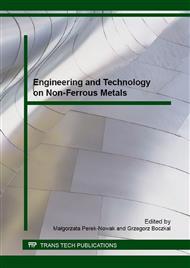p.245
p.252
p.259
p.265
p.270
p.276
p.284
p.293
p.299
Copper Metal Matrix Composites Reinforced by Titanium Nitride Particles
Abstract:
Copper based Metal Matrix Composites are promising materials for electrical and electrotechnical applications such as electronic packaging and contacts, resistance welding electrodes, heat exchangers etc. Introducing the ceramics particles into the copper matrix allows to achieve a higher mechanical properties comparing to pure copper. The literature shows the variety of reinforcement materials are used. The most commonly strengthening phase include: oxides Al2O3,Y2O3, SiO2, carbides SiC, WC, TiC, ZrC, borides TiB2, ZrB2 and others such us volcanic tuff, carbon or intermetalic phases Al-Fe. [1-7]. It is obvious that reinforcement material without TiN leads to decrease the electrical conductivity of copper. Preliminary investigations concerning nanoscale Cu-based composites with TiN particles were presented in papers [10, 11]. Powder metallurgy (PM) process leads to obtain uniform distribution of strengthening phase in matrix. In order to achieve uniform distribution the process parameters such as mixing and selection the sizes of particles must be appropriate selected. The another factor of decreasing the mechanical and electrical properties by using PM route is porosity. Conventional PM process includes pressing and sintering does not always allow to achieve the high density what is one of the main criterion for high electrical conductivity material. The hard ceramic particles in metal matrix which are not deformable make difficult the densification process. In some cases the use of more advanced methods of production is desirable. The use of titanium nitride particles is justified by their high electrical conductivity in compare to the other reinforcement materials.
Info:
Periodical:
Pages:
270-275
Citation:
Online since:
February 2016
Authors:
Keywords:
Price:
Сopyright:
© 2016 Trans Tech Publications Ltd. All Rights Reserved
Share:
Citation:


